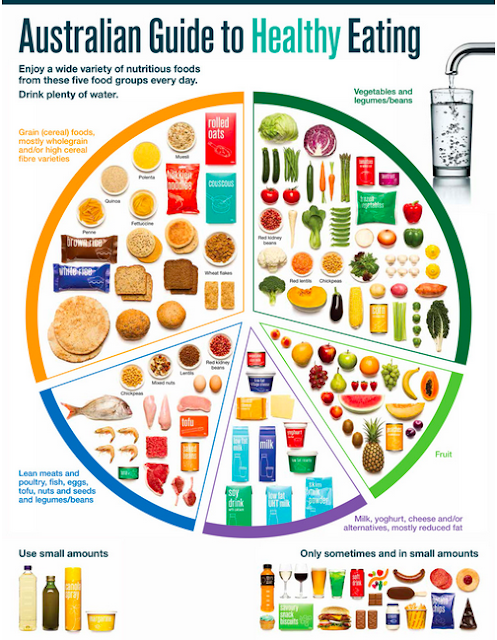| Dr Atkins |
WHAT IS IT?
Dr Atkins, who was a well-known
cardiologist, initially developed the Atkins diet also commonly known as the
“low-carb diet”.
Through limiting his patients’ sugar and
carbohydrate intakes, Dr Atkins was able to provide a successful diet plan to
his patients.
So how does this work?
The body can burn 2 types of fat.
1. Sugar; turned from carbs and or 2. Body fat
Limiting the amount of carbohydrates (sugar),
therefore allows the body to also burn body fat for its fuel source. (Atkins Nutritionals, 2015, para. 2,3,4)
 |
Image 1. (How Does Atkins Work, 2015)
|
 |
| Image. 2 (The 4 phases of the Atkins Diet, 2014) |
SO IS IT GOOD OR BAD?
 |
| Image. 3( Comparing Diets: How does Atkins stand out, 2015 ) |
In the Australian Department of
Health’s (2015) “The Australian Dietary’s 2nd Guideline” (ADG)
suggests that we “ Enjoy a wide variety of nutritious foods from
these five groups every day”
(para. 3)
 |
| (The Australian Guide to Eating Healthy, 2013) |
Thousands
of nutrition experts and studies have produced “a set of standards that define
the amounts of nutrients that best support health” (Whitney, Rolfes, Crowe, Cameron-Smith & Walsh,
2014, p. 16-19),
preventing obesity and chronic diseases. The recommendations called NRV
(Nutrient Reference Values).
According
to these values, the ADMR (Acceptable Macronutrient
Distribution Ranges) of:
- Carbohydrates 45-65%
- Fat 20-35%
- Protein 15-25%
Following the Atkins diet, with reference to image 2 and 3 the carbs values won’t be satisfied.
Values for protein will
also highly exceed its recommended intake. Whitney, Rolfes, Crowe, Cameron-Smith & Walsh (2014) suggests that by limiting carbohydrate
intake, dieters naturally “overemphasise” the intake of protein; meat, fish,
cheeses, eggs and poultry. Often shunning pastas and breads even fruits and
vegetables” (pg. 215).
If you are looking for a healthy
diet that DOESNT RISK your health, reducing carbs to it’s lowest and protein
intake to its highest percentage is advised.
Don’t go above and beyond!
Guideline 3: " Limit intake of foods containing saturated fat, added salt, added sugars
and alcohol "
Image 3 suggests in avoiding sugar, refined flour and trans fat. This satisfies the requirements of the 3rd guideline. Our bodies do need fat, as Whitney, Rolfes, Crowe, Cameron-Smith & Walsh (2014) supports "Fat has some virtue".
However both too little or excess consumption of fat can lead to poor health; diseases such as Obesity, Heart Disease Cholesterol and Cancer.
When choosing what to eat, we can all pick the 'good' fats. (p. 122-148)
- Go for naturally occurring unsaturated fats and oils - avocado, nuts or olive
- Use butter rather than hydrogenated shortenings
- Choose polyunsaturated and monounsaturated margarines and oils
Guideline 4: " Encourage, Support and Promote Breastfeeding "
The Australian Breastfeeding Association (2014) suggests that "A sensible balanced diet is the key", as breastfeeding is the complete source of food with all the nutrition for the first 6 months of life.
This implies that by cutting carbs and generally undertaking any action to impact negatively on your balanced diet, the baby may not be able to get all the nutrients it has to get.
Although many mothers worry about their weight-gain during pregnancy, it is required of the mothers to remain in a well-nourished state, in order for their child to be also. So maybe the diet can come a little later?
Through Atkins, some dieters had seen an improvement in their cholesterol levels during and after the diet. (About Health, 2015)
Also eliminating the 'bad carbs' (refined carbs) such as white bread and cakes improves health. (About Health, 2015)
People who follow this diet plan, do lose weight and successfully keep it off due to the change in lifestyle. (Atkins Nutritionals, 2015)
Lastly to finish off today's post... Some words to encourage you with your dieting journey!
Let’s go from FAST àFEAST
Remember everyone’s body is different!
Losing weight isn’t the end of it. Keeping it
off is.
Keep Fit! ADG’s 1st
guideline is to “ be
physically active + choose amounts of nutritious food and drinks to meet your
energy needs” (Australian Department of Health & Ageing, 2015)
-
Not everyone's body responds the same
way to different approaches to losing weight. The key is to find a match for
your body and metabolism (Atkins Nutritionals, 2015, para. 1).
References
About
Health. (2015). The Pros and Cons of Atkins Diet. Retrieved from http://weightloss.about.com/od/morediet1/qt/blatproscons.htm
Atkins
Nutritionals. (2015). How Does Atkins Work? Retrieved from http://www.atkins.com/how-it-works
Department
of Health and Ageing. (2015). The Australian Dietary Guidelines. Retrieved from
https://www.eatforhealth.gov.au/guidelines/australian-dietary-guidelines-1-5
The
Australian Breastfeeding Association. (2014). Breastfeeding FAQS. Retrieved
from https://www.breastfeeding.asn.au/bf-info/your-baby-arrives/breastfeeding-faqs
Whitney, E., Rolfes, S., Crowe, T., Cameron-Smith, D., Walsh, A.,
(2014). Understanding Nutrition: Australian and New Zealand Edition (2nd
Ed.). South Melbourne, VIC: Cengage Learning Australia.
Images:
Atkins
Nutritionals. (2015). How Does Atkins Work? Picture retrieved from http://www.atkins.com/how-it-works
Atkins Nutritionals. (2015). Comparing Diets: How does
Atkins stand out.
Authority Nurtition. (2014). The
Atkins Diet: Everything You Need to Know (Literally). Picture retrieved from http://authoritynutrition.com/atkins-diet-101/
Department of Health and
Ageing. (2015). The Australian Guide to Healthy Eating. Canberra © Commonwealth of Australia. Picture retrieved from https://www.eatforhealth.gov.au/sites/default/files/files/the_guidelines/n55_agthe_large.pdf